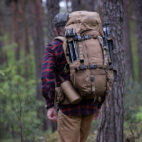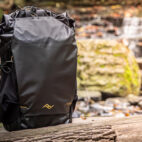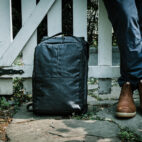Drive By :: BO Gear Spare Camel
Self-confessed ‘backpack nerd’, Andrew W, drops in for a guest post…
I need a decent backpack.
As a dad with two very small kids, I am the proverbial camel of the family, carrying loads of random kids’ gear whenever we head out the door. On top of that, living and studying in Japan means getting around on a bike and public transport a lot, so I need a large bag for a laptop and books, and possibly groceries when I come home. The weather here in the northernmost island of Japan (Hokkaido) can be quite extreme too (6 metres of snow a year), so I needed something that could handle bike commutes through rain, sleet and snow. And finally, I find myself travelling a lot, and so I need something good for overhead compartments in planes.

Enter the Spare Camel.
Handmade in Australia by Brisbane Outdoor Gear (BO Gear), it’s the little messenger bike bag company that could. It’s designed and built by Dave Bell – the guy who answers the phone, updates the website and replies to emails. In early January I gave Dave a call asking for a custom-made BO Gear Spare Camel, and within a tight time frame. Not only did he come through with the goods, he even sent me a studio photo of the bag ahead of time so I would be left waiting in anticipation for its arrival in the post!
The great thing about BO Gear is their Custom Design feature where you customise a bag to the colour scheme of your choice – from the fabrics all the way to the bartacking. I know, for some of you this is a dream come true, and for others (like myself) that sounds like a nightmare. Don’t worry, there are dozens of sample photos to give you ideas, or you can just stick with standard colour schemes. Or if you’re really daring you can try out their WTF options and get a complete surprise of random colours.
[Note: The gold webbing seen on this bag is no longer available on the BO Gear website. Also, whilst BO Gear does provide the option to add paracord to zipper pulls, the reflective paracord zip pulls seen on this bag were purchased separately and added by the author.]
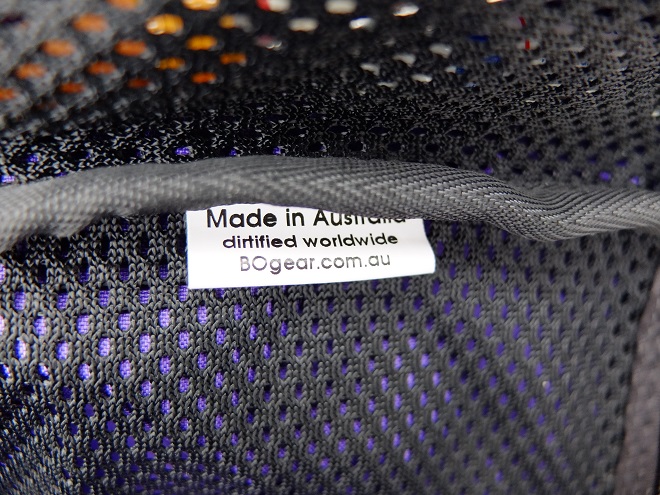
Who It Suits
The primary audience for this bag are bike commuters, outdoor folk looking for a daypack and one-bag travellers who are looking for a versatile, simple and tough backpack that’s on the larger end of the scale.
At 30 litres capacity, it’s not a small bag – so ideally this is a bag for those who feel the need to carry a lot of stuff. The website claims it can carry a carton of beer, a claim I haven’t tested but that should give you a sense of the Spare Camel’s capacity.
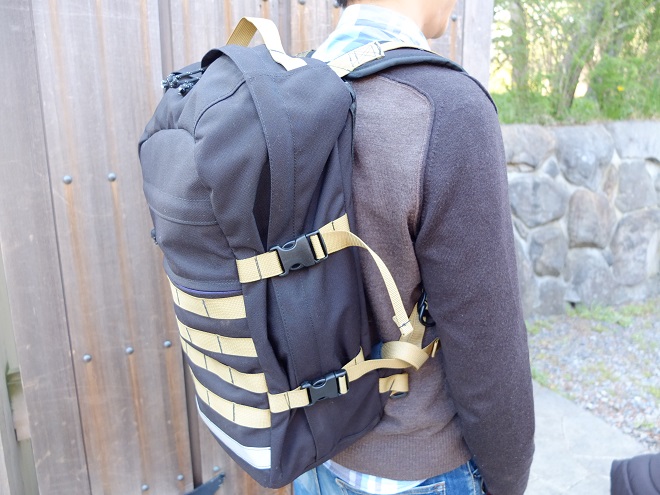
Who It Doesn’t
Those looking for a more subtle silhouette, i.e. those who prefer small or medium-sized bags.
Those who crave bags with lots of externally accessible pockets. No water bottle pockets or fleece-lined sunglasses pockets here.
It’s hard to say if this is an office-friendly bag – PALS webbing doesn’t always suit the office environment, but perhaps if you’re careful with the colour choice it could work out.

The Good
Design
BO Gear’s mantra is “Dirtify Me” and everything about the bag’s design tells you it’s ready for rough handling: 1000D Cordura fabric, the ITW Nexus buckles and D rings, the seat belt webbing at the shoulder straps, the PALS webbing, the #10 YKK zip on the main compartment. I don’t see the point of a bag you need to handle with kid gloves, and this isn’t one of those bags.
“…everything about the bag’s design tells you it’s ready for rough handling…“
On the front of the bag is the PALS webbing. For the uninitiated, this is something the military came up with for creating a modular solution for carrying items very securely on bags and tactical vests. For some, the PALS webbing is a bit of a turn off, and gives off a ‘tacti-cool’ vibe. But the truth is, proper PALS webbing sewn into a strong fabric (like 1000D Cordura) is really useful, as it effectively allows you to strap items securely to the outside of your bag. It’s a bit like how a roof rack on a car gives you extra options when you’re carrying a lot. BO Gear sells a variety of gear which is designed to mate perfectly with the PALS webbing, including the Cellblock M and the Royd Bike Bag, which is designed to help you ride to and from the airport with your bike (a great idea). Alternatively, with a bit of rope, you can just use the PALS webbing to cinch down oversized items.
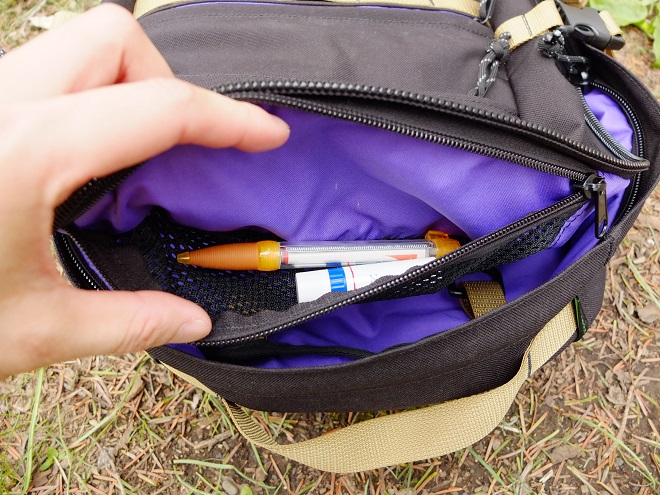
The top handle is a simple strip of webbing bartacked to the top fabric. Not the most comfortable on your hands for long-term carrying, but does the job. It’s a backpack after all. On each side of the handle is an extra length of bartacked webbing, so you can clip items to the side of the handle as well.
On the sides are compression straps with plastic side-release buckles. The standard Spare Camel comes with one compression strap, but I opted for two to enable carrying longer items like tripods and blankets.
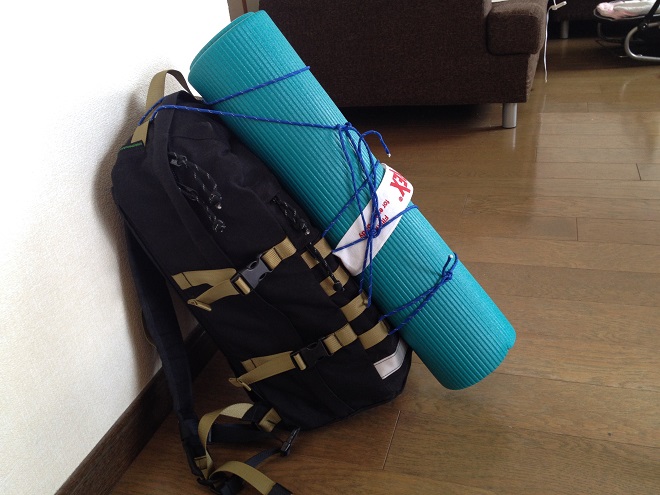
The inside of the bag is lined with a soft 300D polyester. It’s a great idea to have the liner a bright colour so you can easily see the contents of the bag. The standard bags come in light grey, but you can opt for some more eye-popping purple, red or royal blue.
There are three internal mesh pockets. I was quite surprised at the thickness of the mesh fabric – there’s no need to worry that something might snag the mesh and rip it as it feels seriously tough.
The shoulder straps are wide, tapered and moderately padded. I’ve certainly had more cushy shoulder straps before, albeit on hiking packs. The top of the shoulder straps are not sewn into the bag itself, but are ‘floating’ via a piece of thick seatbelt webbing. The idea of this is to allow the straps to be able to twist a bit more according to the shape of the wearer. I regularly carry 7-8kg loads and I’ve found the bag quite comfortable.
The bag is also taller than the shoulder straps, i.e. the top of the bag is not where the shoulder straps meet the bag – it’s a few more centimetres above. Dave tells me this makes the bag stronger. I also think it makes the bag contents sit higher up and closer to your back – which is great for stability and comfort when carrying heavy loads.
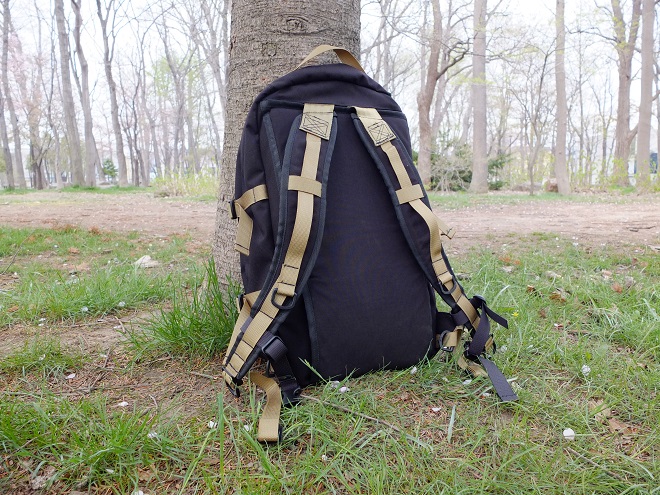
The shoulder straps are designed to be able to loop through hydration tubes, attach sternum straps at two different heights and have a D ring for further attachments. The straps themselves can be loosened quickly with quick-release D rings on the adjuster buckle, though I haven’t found myself using them much. There are Velcro strap keepers on the ends of the shoulder strap webbing, so you can avoid having long shoulder strap webbing flapping around. At the bottom point where the shoulder strap attaches to the bag, there is another D ring for even more attachment options.
The back panel of the bag is a completely plain piece of 500D Cordura. There’s no air-mesh, no bumps, no ridges, no trampoline…nothing for back ventilation. For some of you this is a relief – instead of non-functioning fabric technology which only makes you itchy, it just keeps things simple. I haven’t worn the Spare Camel in warmer seasons yet – but my friends who have toured with the backpack through Thailand reported quite a sweaty back.
“There’s no air-mesh, no bumps, no ridges, no trampoline…nothing for back ventilation.”
Behind the 500D Cordura is a removable and flexible HDPE plastic frame sheet and a piece of 10mm EVA foam. This makes a huge difference in comfort when carrying awkwardly shaped items. Weird bulges are kept away from your back, helping with carrying comfort. It also helps keep the bag straight, helping the bag stand up on its own. It’s a small but great thing to be able to put the bag down and not have to watch it flop over helplessly (well, depending on how you pack it).
Clamshell opening
To be honest, before meeting this backpack I wasn’t really that sold on the idea of a clamshell opening bag. I understood the benefits, but it didn’t seem that great to me. And even now, 95% of the time I open the bag the traditional way – from the top.
But the 5% of the time that I need to grab something from the bottom of the bag, or the times I’m trying to pack the bag carefully, the clamshell design becomes really, really useful and makes you swear off using regular bags ever again.
For example, I can put clothes into the bag folded flat against the back, avoiding the problem of pulling out a wrinkled mess later on. Or I can pack emergency items (like a nappy change mat) right at the bottom of the bag, and when that emergency comes I won’t be furiously digging into the bag to get it out. Or when I’ve got a lot of things to pack, rather than just dumping them into the backpack from the top and hoping for the best, I can lay it flat and try to arrange items to be as high and flat against my back as possible to give greater carrying comfort.
“…the time that I need to grab something from the bottom of the bag…the clamshell design becomes really, really useful.”
And while the bag doesn’t have a water bottle holder, I always try to lay my bottle against the side zip of the bag. That way, I can access the bottle by just unzipping the side of the bag. Not as simple as a regular bottle holder, but pretty close.
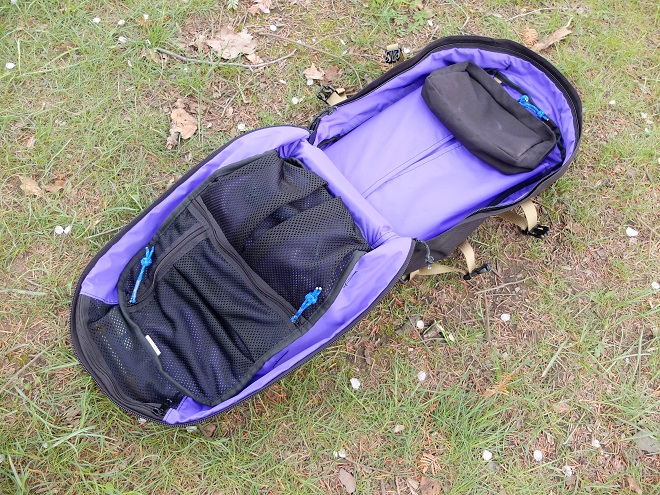
Water resistance
Both the outer 1000D Cordura and 300D polyester liner have a water-resistant backing which makes the bag quite water resistant. Of course, the bag isn’t truly water resistant – the zips and stitching and so forth will inevitably let water in eventually. Nonetheless, the bag has handled itself well so far in bad weather.
Thanks to my daughter, the bag has been dragged through and buried under snow. At the end of winter here when the roads are perpetually wet from melting snow, and despite having a mudguard on my bike, the bag often gets totally covered in water from a bike commute. I’ve also carried the bag through brief rain showers.
So far so good – I find I can just get a towel and wipe the bag and it’s virtually dry and good to go.
“…the bag has handled itself well so far in bad weather.”
However, the outer pocket which sits right behind the PALS webbing isn’t completely water resistant – because the zip isn’t covered with a storm flap. One time when it was sleeting down, water managed to enter in through that zip. I had some books in there that got slightly damp. I suspect wet sleet was piling up on my back, and so it presented the worst case scenario for the bag/zip. (I dunno, I can’t see what’s happening on my back).
However, the rest of the bag contents were fine – i.e. the top external pocket and the main compartment were bone dry. Because of this I make use of a rain cover when I plan to ride my bike through serious rain. But if I’m caught without it I’d still be relatively confident in the bag’s weather resistance (but I now avoid putting paper items in that pocket).
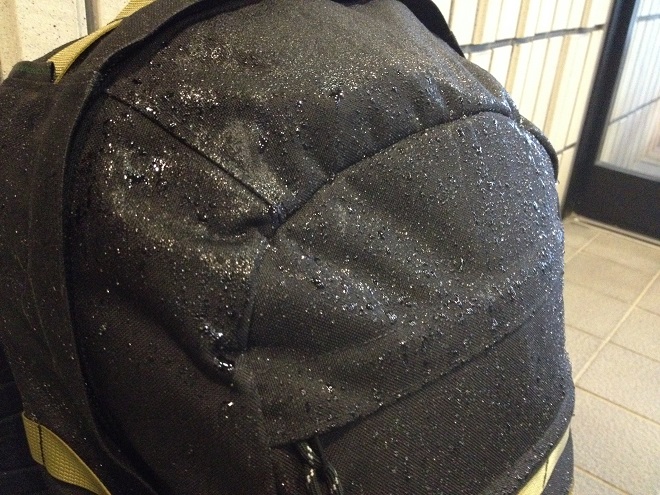
Pocketing
The front of the bag features a tight top pocket, which is perfect for keys, wallet, tissues and any other items you need quickly. Below that is another external pocket that goes all the way to the bottom of the bag. I put other quick-to-grab items here, like a small towel and bike lights. Items in the main compartment tend to push into this pocket, so on days when you’re carrying a lot, it gets quite tight in there. In general, both external pockets are a bit on the tight side – so you’re really more encouraged to put items into the internal pockets.
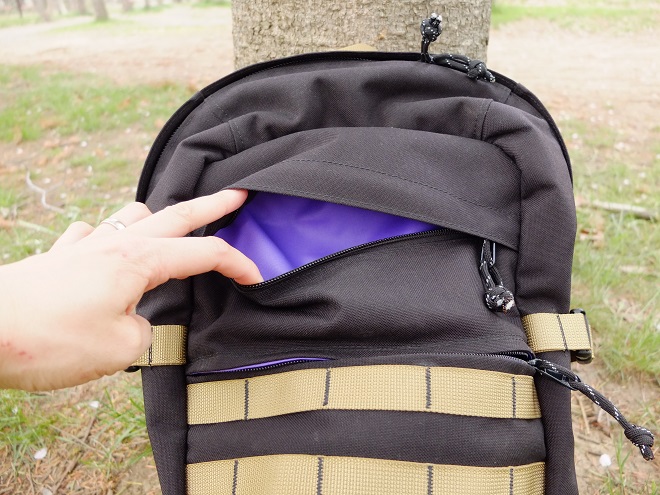
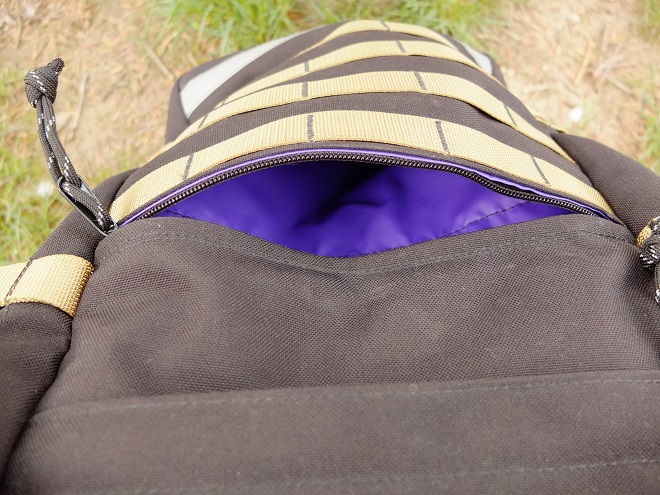
Most backpacks sold today tend to use a secondary compartment that is parallel to the main compartment (e.g. The North Face Surge). This sort of design tends to make ‘secondary items’ fall to the bottom of the secondary compartment, and the bag sticks out further and further away from your back, which messes with your centre of gravity.
“In general, both external pockets are a bit on the tight side – so you’re really more encouraged to put items into the internal pockets.“
The Spare Camel’s internal pocketing essentially does away with a parallel secondary compartment with its internal mesh pockets and tight external pockets. This way the ‘secondary items’ are kept closer to your back, higher up and compartmentalised. I find this makes a big difference in carrying comfort, and in keeping the bag rectangular in shape even when full. Also, the pleating of the internal mesh pockets is a very useful feature – no super-tight pockets that can only store a handful of flat things. You can stick your whole fist in there to hunt around for items.
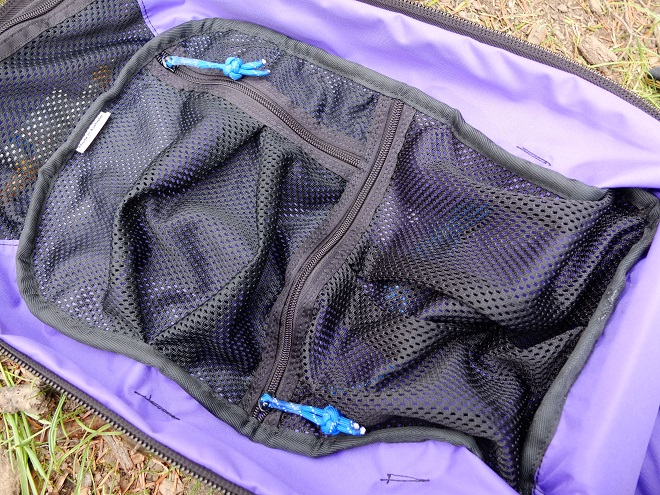
The top mesh pocket for small items is really handy, and it’s in a great location. The bottom mesh pocket is a bit tough to access when accessing the bag from above. However, I like to use that pocket for storing items I rarely access, like a first aid kit.
“…the pleating of the internal mesh pockets is a very useful feature – no super-tight pockets that can only store a handful of flat things.“
What really sets this bag apart from others is the ability to hang a pouch (the BO Gear Cellblock M) on the inside of the bag for more organisation. Depending on the occasion I use it to store small notebooks, pencil cases, food, a camera, computer mouse – basically stuff I need to access once I’m sitting down at my intended destination or stuff that’s too big for the mesh pockets. I love the fact that the Cellblock M is hanging up high in the bag in a location that is normally empty, thus making more efficient use of space. It also helps keep the load of the bag high up as well, which is better for stability and carrying comfort.
In many ways the Cellblock works similar to how traditional ‘cinch top’ rucksacks (e.g. Burton Tinder) have a hanging pocket sitting on the top – which I always thought was useful, but made the bag look funny when empty, since those bags tend to invert into themselves.
As mentioned earlier, the Cellblock M is PALS webbing compatible, so you can attach it to the front of the bag if you need it there. And if you’re really someone who compartmentalises in life, you could possibly swap out different Cellblock M’s depending on the situation, such as one for work, one for camping, etc.
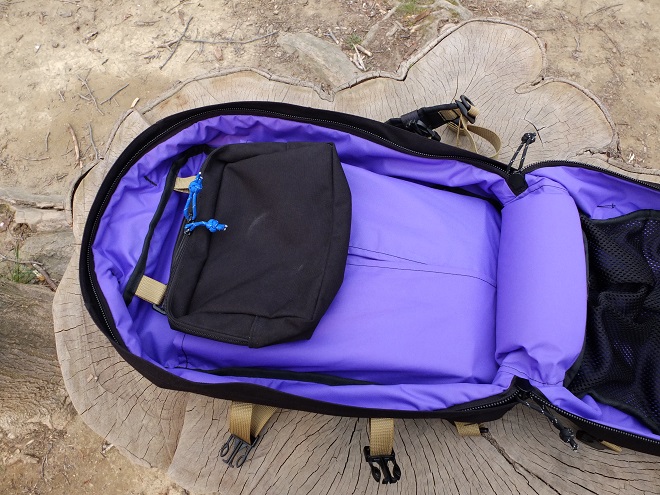
Tip: Put some paracord zip pulls on the Cellblock – it’s a pain trying to locate the little black metal zips when it’s hanging inside your backpack.
On the downside, when accessing the bag from the top the Cellblock M tends to be in the way – you need to get used to flipping it out of the way. Not hard to do, but it’s a hassle. And when the bag isn’t very full, the Cellblock M tends to pull down the roof of the bag a little, which kills the bag’s aesthetic ever so slightly.
Optional Waist Strap
I didn’t actually buy this, but I thought it was really a great design point to highlight. Instead of a thin waist strap that dangles around annoying you when you don’t need it, I love the fact that the bag is able to slot in a full size beefy waist strap for the occasions you’ll really be carrying heavy loads for a long time. And then you can remove it when you don’t want it.
The Not So Good
Internal vertical zip
My biggest issue with the bag is the use of a vertical zip on the internal mesh pocket. When accessing the bag from the top, it’s not the easiest to push the zip down to open the pocket, and it’s hard to pull things out from the pocket at that angle.
“My biggest issue with the bag is the use of a vertical zip on the internal mesh pocket.“
There are ways around this (turn the bag sideways, use it like a ‘Napoleon pocket’) but as a pocket I access regularly I would have really preferred a horizontal zip.
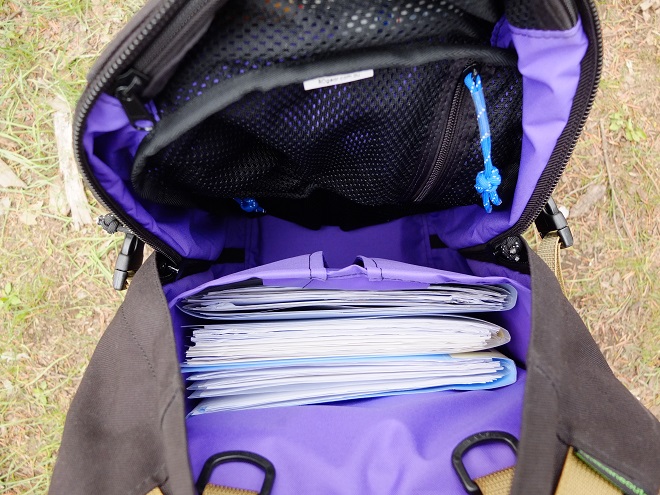
Back ventilation
As mentioned earlier, there is none – it’s just a flat surface covered with 500D Cordura. No bumps, no air mesh, no trampoline.
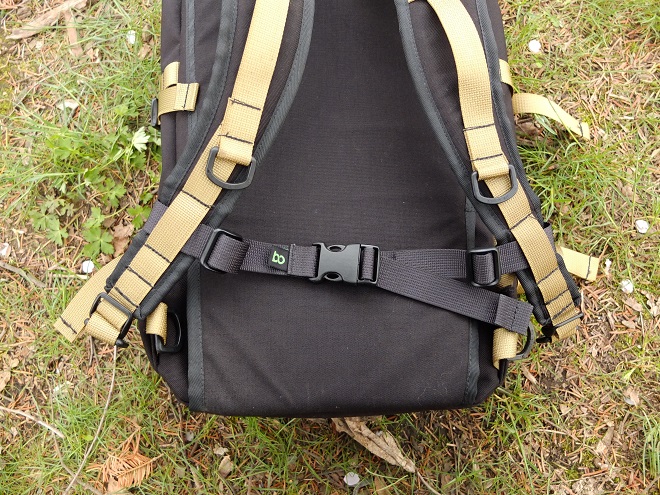
Laptop protection
The bag also lacks any real laptop protection. You really must put the laptop into a sleeve which protects the laptop’s corners and edges. Otherwise when putting the bag on the floor you might hear the unfortunate noise of your laptop kissing the concrete.
Sternum strap
Whilst the sternum strap does the job, it’s not without significant faults. Because of the way the sternum strap attaches to the shoulder straps (i.e. all the way around) I often find it twisted around the shoulder strap and buried in my armpit whenever I’m trying to find it. It’s a bit of a pain every time, and it comes as a surprise to me as other bags I’ve had don’t have this problem at all.
“Whilst the sternum strap does the job, it’s not without significant faults.”
Furthermore, I find it slowly unravels by itself. One time I reached for the sternum strap and it came off completely, much to my surprise. It seemed I hadn’t been paying attention to its slow unravelling. So now I make sure it’s always attached tightly, which is an unwanted hassle. Other bag manufacturers use a sternum strap which connects to the webbing of the shoulder strap (e.g. Tom Bihn sternum strap) with a plastic buckle – I wonder if that would have been a better solution.
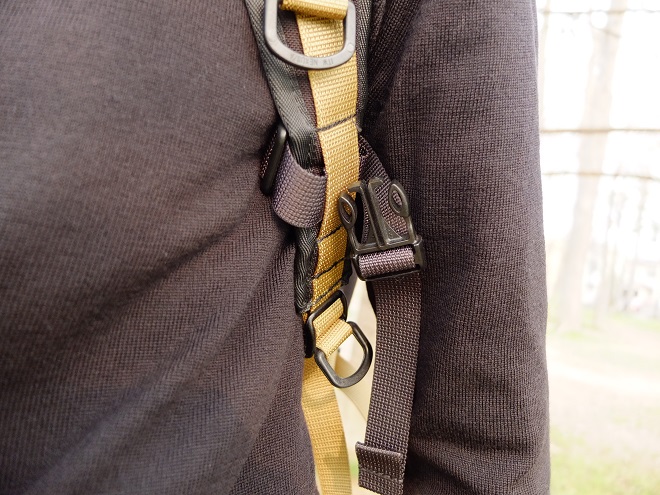
Construction
For the most part, the bag is well put together. The heaviest load I’ve carried included a 10kg bag of rice, and the bag held up without complaint. However, over time some of the stitching has come loose and I’ve found myself trimming threads here and there. The bag also arrived with a less-than-straight line of stitching on one of the side buckles. While it wasn’t critical to the reliability of the bag, small imperfections like that are hard to ‘unsee’ every time you look at the bag.
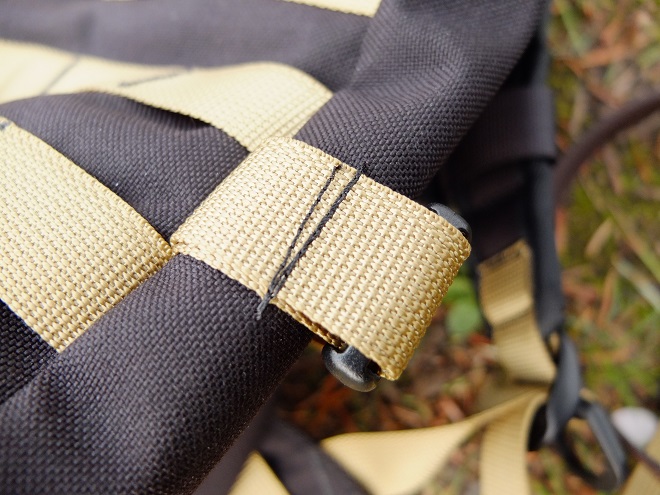
Others to Consider
The look and design of the Spare Camel has a few bags with similar design philosophy out there. It’s impossible not to notice the similarities to the smaller but (probably) tougher Goruck GR1. For those who aren’t interested in PALS webbing, consider the more old-school look of the Madden Equipment Daylite (Note: I’m fairly sure the volume of the Daylite is not 30 litres as advertised – the dimensions of the pack add up to 21.5 litres). Or for a similar size, but a more modern look and lighter fabrics, consider the Crumpler Low Level Aviator 3 Day Pack.
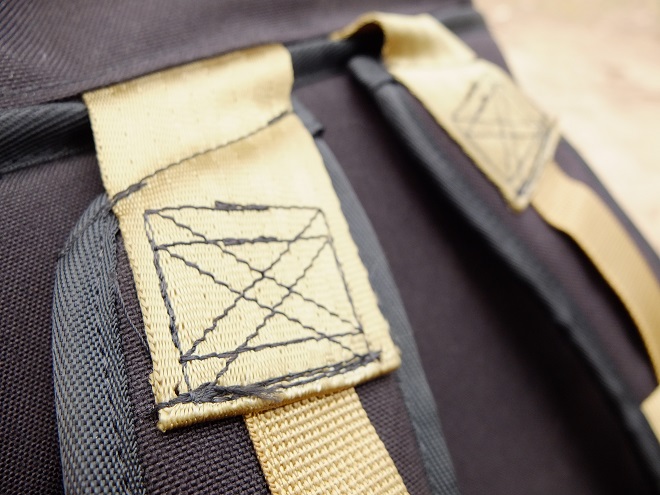
Verdict
I got to say I’ve grown to really love this backpack. It’s tough, it’s versatile and it’s got great functionality. I need to use a backpack every day, and I know I’ll be doing so for quite some time – and so I searched high and low for a backpack I wouldn’t just like, but love. And I think this is it.
I’ll add that as a company which sells its bags only via the Internet, BO Gear does a really great job of marketing its products. I only wanted to buy a bag I could examine in-store, but the simple but effective videos of Dave from BO Gear explaining his bags was crucial in changing my mind. Other online bag manufacturers really ought to take note of Dave’s work.






 Carry Awards
Carry Awards Insights
Insights Liking
Liking Projects
Projects Interviews
Interviews





